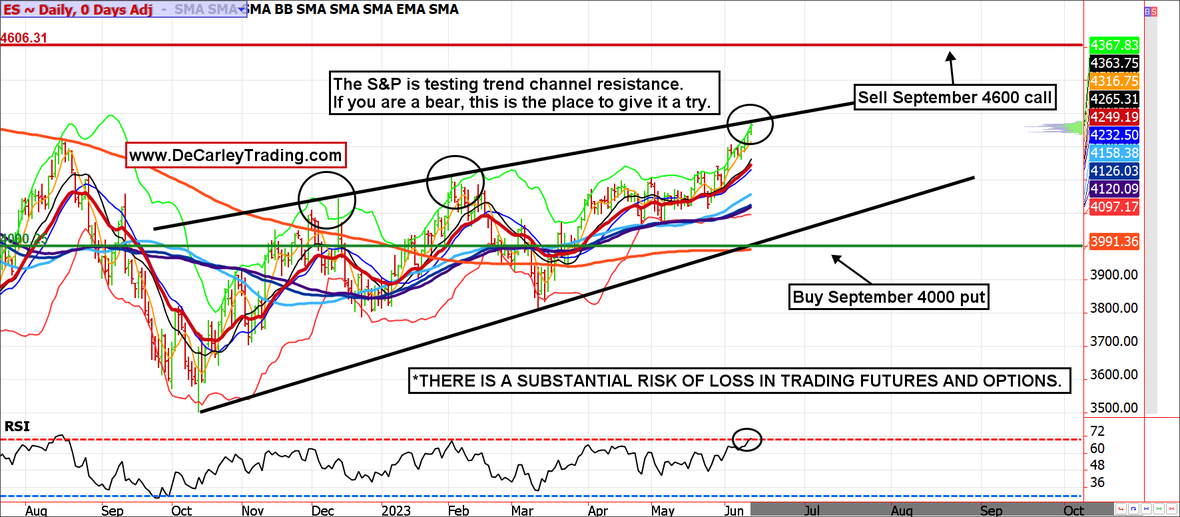Symbols mentioned: ES
Chart Source: QST
Positions: None
Is it time to hedge risk in the S&P 500?
This week has been the perfect storm for a short squeeze in equities. The FOMC decision lands tomorrow, and this morning, we received relatively good news regarding waning inflation; thus, the Fed seems destined for a pause in rate hikes. Further, the June futures and options expire at the end of the week, which is putting pressure on those who have been short and suffering to cover (buy).
That said, the buying has been position-squaring-based, not necessarily fundamental-based, and we are approaching significant technical resistance with the RSI on a daily chart near 70.00. In the short run, the market is vulnerable to a pullback.
If you want to speculate on declining equity prices or hedge your portfolio, a risk reversal seems to make sense. This is the practice of selling a call option (currently overpriced due to the relentless uptrend) and buying a put option (which is underpriced due to the low VIX reading).
Specifically, we like selling the September S&P 500 4600 call and using the proceeds to buy the 4000 put, the cost of the spread is about $50 plus transaction costs, but risk above 4600 is unlimited for speculators. If this is done as a stock portfolio hedge with an allocation similar to the S&P 500, the risk is an opportunity cost (gains over 4600 are foregone because above that price, the portfolio is gaining, but the hedge is losing, point for point). When done as a hedge, this is a strategy that offers relatively free insurance in exchange for accepting a profit cap above 4600.
A more popular but less efficient portfolio hedging strategy is to buy puts to act as portfolio insurance. This method leaves the upside profit potential open and covers the downside risk beneath the strike price of the put option purchased, but this approach can become quite expensive. For example, purchasing the September 4000 put outright would cost a little over $1,500 for just under three months of protection under 4000. With the September E-mini S&P futures contract at about 4400, the insurance would only pay off if the S&P was 430 lower at expiration (400 points to reach the strike price and another 30 to cover the premium paid); even at that price, it merely breaks even. This means the portfolio still suffered a drawdown in the amount of 400 S&P 500 points plus despite the attempted hedge. If an investor opted to buy similar insurance each quarter, he would be out about $6,000 in premium paid for puts (insurance), or about 2.5% to 3% annually, to protect against sell-offs exceeding about 10%. Most stock market corrections are 10% or less; also, most portfolios wouldn’t fare well if you shaved 3% of the top every year. Yet, a risk reversal strategy (reserved for appropriate timing) removes the cost burden of protecting the downside.
It should be noted that the CME Group offers micro-sized options against the stock indices, allowing for speculation and portfolio hedging in smaller increments. With the S&P 500 at 4400, the E-mini S&P 500s notional value is about $220,000; the micro-sized version is $22,000. Thus, those looking to hedge $22,000 worth of stocks could construct the aforementioned risk reversal strategy using the micro E-mini options.
Due to the volatile nature of the futures markets some information and charts in this report may not be timely. There is substantial risk of loss in trading futures and options. Past performance is not indicative of future results. The information and data in this report were obtained from sources considered reliable. Their accuracy or completeness is not guaranteed and the giving of the same is not to be deemed as an offer or solicitation on our part with respect to the sale or purchase of any securities or commodities. Any decision to purchase or sell as a result of the opinions expressed in this report will be the full responsibility of the person authorizing such transaction.
Editors’ Picks

Gold hovers around all-time highs near $3,250
Gold is holding steady near the $3,250 mark, fuelled by robust safe-haven demand, trade war concerns, and a softer-than-expected US inflation gauge. The US Dollar keeps trading with heavy losses around three-year lows.

EUR/USD retreats towards 1.1300 as Wall Street shrugs off trade war headlines
The EUR/USD pair retreated further from its recent multi-month peak at 1.1473 and trades around the 1.1300 mark. Wall Street manages to advance ahead of the weekly close, despite escalating tensions between Washington and Beijing and mounting fears of a US recession. Profit-taking ahead of the close also weighs on the pair.

GBP/USD trims gains, recedes to the 1.3050 zone
GBP/USD now gives away part of the earlier advance to fresh highs near 1.3150. Meanwhile, the US Dollar remains offered amid escalating China-US trade tensions, recession fears in the US, and softer-than-expected US Producer Price data.

Bitcoin, Ethereum, Dogecoin and Cardano stabilze – Why crypto is in limbo
Bitcoin, Ethereum, Dogecoin and Cardano stabilize on Friday as crypto market capitalization steadies around $2.69 trillion. Crypto traders are recovering from the swing in token prices and the Monday bloodbath.

Is a recession looming?
Wall Street skyrockets after Trump announces tariff delay. But gains remain limited as Trade War with China continues. Recession odds have eased, but investors remain fearful. The worst may not be over, deeper market wounds still possible.
RECOMMENDED LESSONS
Making money in forex is easy if you know how the bankers trade!
Discover how to make money in forex is easy if you know how the bankers trade!
5 Forex News Events You Need To Know
In the fast moving world of currency markets, it is extremely important for new traders to know the list of important forex news...
Top 10 Chart Patterns Every Trader Should Know
Chart patterns are one of the most effective trading tools for a trader. They are pure price-action, and form on the basis of underlying buying and...
7 Ways to Avoid Forex Scams
The forex industry is recently seeing more and more scams. Here are 7 ways to avoid losing your money in such scams: Forex scams are becoming frequent. Michael Greenberg reports on luxurious expenses, including a submarine bought from the money taken from forex traders. Here’s another report of a forex fraud. So, how can we avoid falling in such forex scams?
What Are the 10 Fatal Mistakes Traders Make
Trading is exciting. Trading is hard. Trading is extremely hard. Some say that it takes more than 10,000 hours to master. Others believe that trading is the way to quick riches. They might be both wrong. What is important to know that no matter how experienced you are, mistakes will be part of the trading process.

The Best brokers to trade EUR/USD
SPONSORED Discover the top brokers for trading EUR/USD in 2025. Our list features brokers with competitive spreads, fast execution, and powerful platforms. Whether you're a beginner or an expert, find the right partner to navigate the dynamic Forex market.

